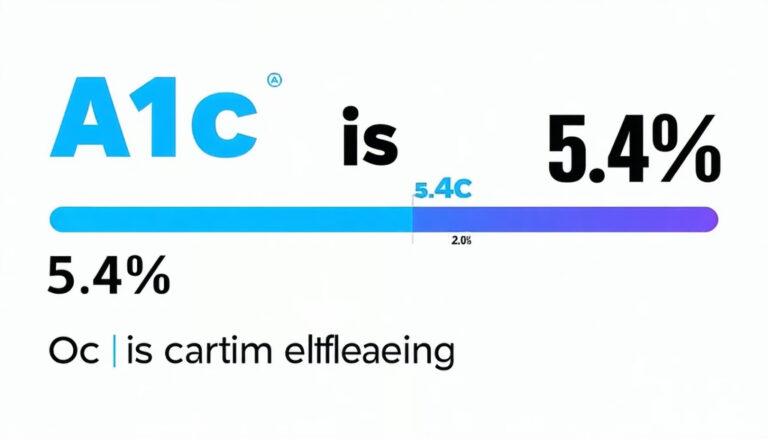Decoding A1C: Our Journey to Understanding LADA Results
Join us as we explore understanding A1C results in LADA—discover tips, treatments, and personalized management strategies!
Understanding A1C Results in LADA
Introduction to LADA Diabetes
Hey there! Let’s chat about Latent Autoimmune Diabetes in Adults, or LADA. It’s that quirky kind of diabetes that struts into your life after you’re 30, unlike its type 1 cousin that makes an entrance in your teens. Unlike type 1, you won’t find yourself grappling with insulin shots immediately. Nope, LADA takes its sweet time breaking down those insulin-making cells until, eventually, insulin therapy becomes your new best friend.
LADA’s like a mixed bag, kinda like a mashup of type 1 and type 2 diabetes, which makes figuring out and managing those A1C levels pretty important. We’re here to dive into how LADA tinkers with your A1C readings and what game plan works best.
Difference from Type 1 and Type 2
LADA’s got some tricks up its sleeve that set it apart:
- Age of Onset: Type 1? Sneaks up on kids and teens. Type 2? Think middle-aged or older adults. LADA? It’s all about the adults over 30.
- Autoimmunity: LADA folks have autoantibodies that like to crash the glutamic acid decarboxylase (GADA) party. It’s similar to type 1 in this autoimmune shindig but type 2 skips this altogether.
- β-cell Dysfunction: Ah, the famous beta cells. With LADA, these cells malfunction at a speed somewhere between a cozy type 2 slo-mo and the type 1 sprint. It’s a quicker decline in those lil’ C-peptides compared to type 2.
- Insulin Requirements: LADA’s insulin entrance is kind of like picking a movie on Netflix – not immediate, but definitely on the horizon much quicker than in type 2 diabetes.
- Body Mass Index (BMI): LADA’s team is usually on the leaner side compared to the typically heftier type 2 crowd.
Here’s a quick comparison table to paint the picture:
| Feature | Type 1 Diabetes | Type 2 Diabetes | LADA |
|---|---|---|---|
| Age of Onset | Childhood/Adolescence | Middle-aged/Older | Over 30 |
| Autoimmunity | Yup | Rare | Yup |
| β-cell Dysfunction | Fast | Slow | In-between |
| Initial Insulin Requirement | Right away | Later | Soon-ish |
| Body Mass Index (BMI) | Lean/Normal | Higher | Normal/Lean |
Getting a grip on these differences helps decode how LADA messes with A1C results. For extra juicy details on keeping tabs on A1C levels if you’re dealing with LADA, check out our guide on A1C tests for LADA folks. It’ll make managing LADA less of a head-scratcher and more of a breeze.
Importance of A1C Levels
Grasping your A1C levels is a game-changer for managing latent autoimmune diabetes in adults (LADA). Here, we’ll unpack why the A1C test is such a big deal in keeping blood sugar in check and what targets folks with LADA should aim for.
A1C Test and Blood Sugar Control
The A1C test is like a report card for your blood sugar over the past couple of months. It checks how much sugar is hanging out with your hemoglobin, those key proteins in your blood. If that A1C number’s climbing, it’s a red flag that blood sugar’s been running high, upping the risk for some of those nastier diabetes complications.
| A1C Level (%) | Average Blood Sugar Level (mg/dL) | What’s Up With That? |
|---|---|---|
| Below 5.7% | Below 117 | A-okay, keep it up! |
| 5.7% to 6.4% | 117 to 137 | Prediabetes territory |
| 6.5% or higher | 137 or more | Diabetes things |
This quick look at the numbers makes sense of your A1C results.
The A1C test helps in a bunch of ways:
- Diagnosis: It’s the go-to test for officially saying “Yep, it’s diabetes.” An A1C of 6.5% or more? Bingo.
- Monitoring: Let’s you peek at how well your diabetes game plan is doing. If you’re hitting those goals, testing twice a year might be just fine. But if the plan gets shaken up, or goals slip away, you might need to check in more often.
A1C Targets for LADA Patients
Figuring out that sweet spot for A1C results in LADA isn’t a one-size-fits-all deal. It takes a good look at age, overall vibes, and personal needs. Most grown-ups with diabetes, LADA included, shoot for less than 7% A1C, keeping risk at bay.
A1C Targets Table
| Patient Vibe | Target A1C (%) |
|---|---|
| Most folks with LADA | Below 7% |
| Older adults or not looking too far ahead | 7.5% to 8% |
| Youngsters or kids | Under 7.5% |
It’s smart to chat with your healthcare crew to nail down your personal A1C target. It might flex based on things like health conditions and how long diabetes has been around.
To get the down-low on how lifestyle shifts and treatment tweaks can adjust your A1C scene, take a peek at our tips on managing A1C in LADA.
Keeping tabs on your A1C and aiming within the suggested ranges can seriously boost how you handle LADA. It’s a big player in avoiding those long-term complications and living your best life. For a deeper look into reading your A1C numbers, check out our guide on interpreting A1C readings in LADA.
Monitoring and Managing A1C
Keeping tabs on our A1C levels is pretty much the bread and butter of handling latent autoimmune diabetes in adults (LADA). This number lets us know if our blood sugar has been a good kid or not, and whether it’s time to tweak our game plan.
Impact of Insulin Treatment
Insulin is like the star player when managing LADA, and it’s got a direct line to our A1C levels. If that A1C is riding high, we might have to fiddle with our insulin doses, or revisit what we’re eating, or do both at the same time (Mayo Clinic). When our insulin therapy is on point, it can bring our A1C down and cut the odds of those pesky diabetes complications (source).
Continuous Glucose Monitoring (CGM) is another trusty sidekick. These devices show us real-time sugar levels, so we can quickly adjust our insulin and dodge those dangerous low sugar moments. This real-time feedback is a lifesaver when striving to hit our A1C targets (source).
| A1C Level (Percent) | Interpretation |
|---|---|
| Less than 7% | Sweet spot for most grown-ups |
| 7% to 8% | Might need a tweak or two |
| Above 8% | Probably time to shuffle the plan |
Take a deeper dive into this on our page about a1c tests for lada patients.
Lifestyle Factors and A1C Levels
A lot of what keeps our A1C in check boils down to how we live. Just moving around more—walking, cycling, or swimming—can help us drop those pesky sugar levels and keep them low for the win.
And let’s talk about grub for a sec. Chowing down on whole grains, lean proteins, and veggies helps keep our blood sugar steady. On the flip side, sugary and fatty foods can send those sugar numbers soaring, wreaking havoc on our A1C.
Don’t forget the mind and body. Stress can mess with our sugar levels, and not catching enough Z’s can throw our insulin sensitivity right out the window. So, some mindfulness, a bit of yoga, or just good sleep habits can do wonders for our blood sugar.
Mix these lifestyle hacks in with regular A1C monitoring, and we’re on our way to tackling LADA like champs. Check out more tricks for keeping your A1C in the green in our article on managing a1c in lada, along with loads of handy tips on interpreting a1c readings in lada.
Challenges and Considerations
Autoimmunity and A1C Variability
So, let’s talk about A1C results and LADA. It’s a bit like untangling Christmas lights. Unlike Type 2 diabetes, folks with LADA see higher A1C numbers partly because of this sneaky thing called autoimmunity. They tend to be younger and leaner when diabetes comes knocking and often need insulin pronto. Many initially get tagged incorrectly as Type 2, which is like buying a ticket for the wrong bus. This delays proper treatment and could mean hopping on the insulin express within five years after a misdiagnosis. It’s like playing catch-up while using the wrong tools (NCBI).
We really need a rule book for figuring out and treating LADA the right way. The Immunology of Diabetes Society has pitched in with three big hints: gotta be over 30, test positive for an autoantibody, and no insulin for the first half-year after diagnosis (PubMed Central).
Individualized Approach to LADA Management
Now, let’s not put everyone in the same box when talking about LADA. These aren’t your run-of-the-mill diabetes cases. People with classic T1DM have more symptoms right from the start, tend to weigh less, and flaunt more autoantibodies. This points to a more fiery autoimmune reaction compared to their LADA counterparts. That means we need to get personal, like a custom coffee order, when managing blood sugar swings and any sneaky complications.
We gotta lean on insulin therapy guided by C-peptide levels, toss in a mix of other meds, and keep those sugar issues in check. Some therapies, like those cool-sounding dipeptidyl peptidase 4 inhibitors and glucagon-like peptide 1 receptor agonists, might save the day by keeping those β-cells ticking longer (Cureus). Don’t forget about shaking things up with tailored diets and exercise routines.
Managing A1C levels for those with LADA is a dance requiring finesse and a plan tailored to what makes each person tick. To dive into more tips and tricks on reigning in those levels, swing by our article on managing A1C in LADA.








Leave a Reply